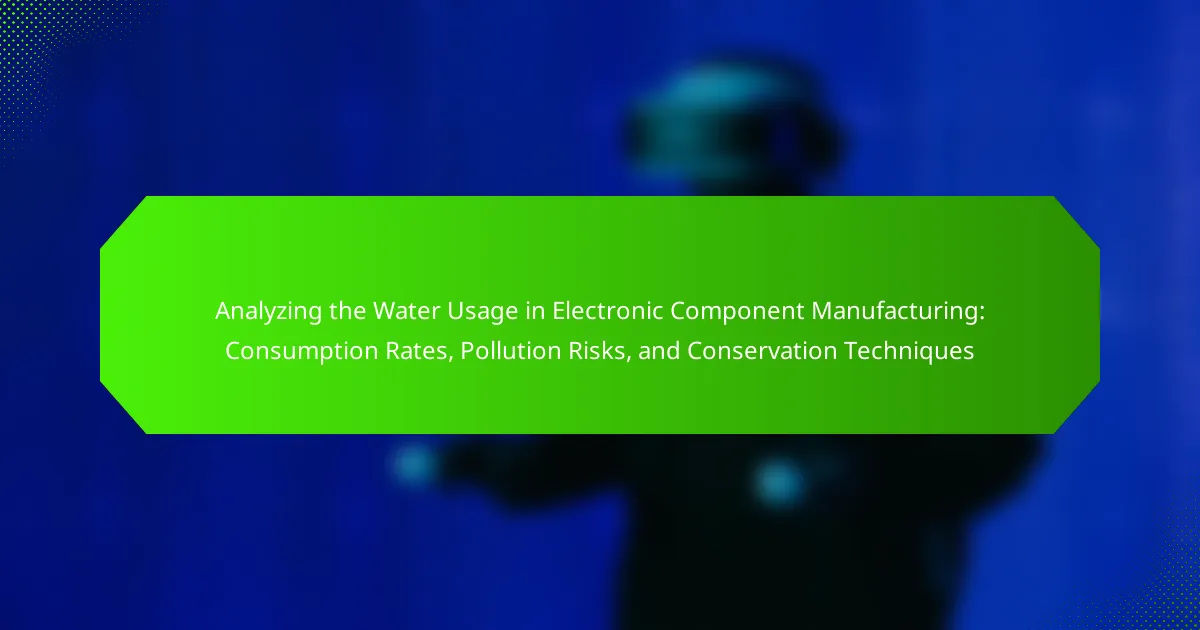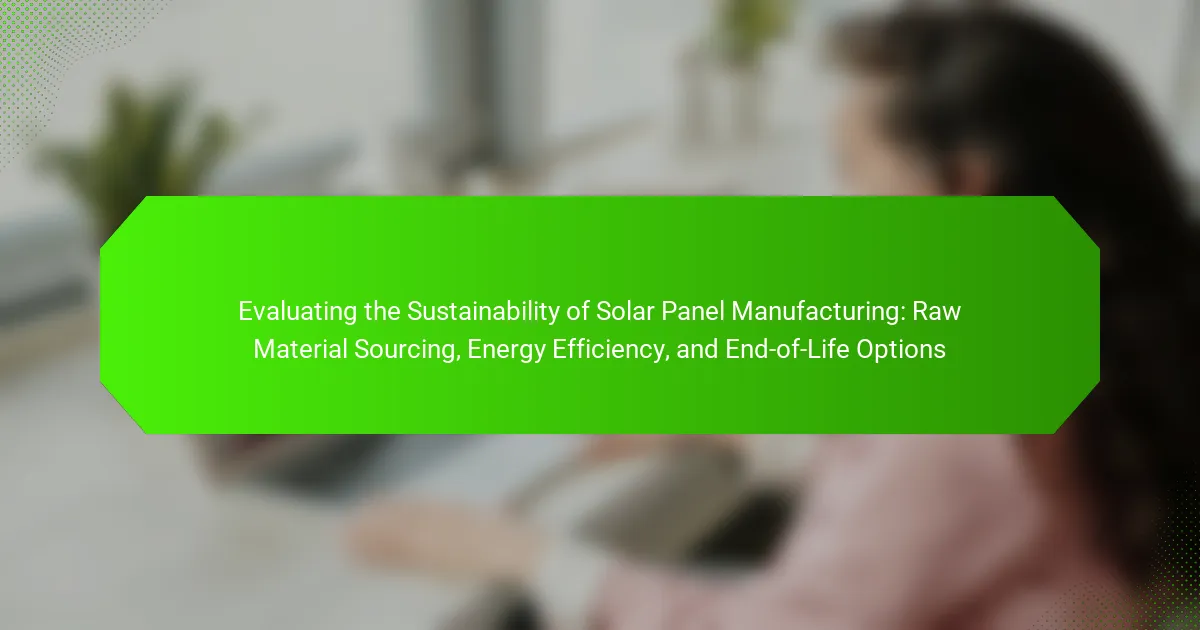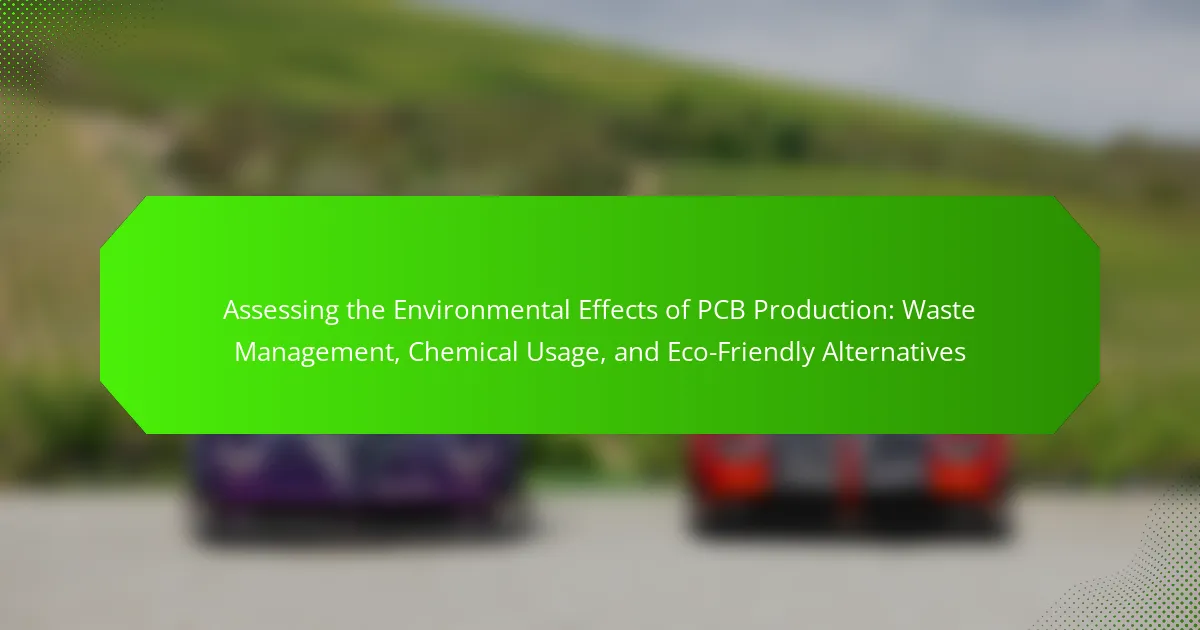Water usage in electronic component manufacturing is critical for various processes, including cooling, cleaning, and chemical applications. The semiconductor industry consumes between 2,000 to 5,000 gallons of water per chip, necessitating high-purity water for effective production. This article examines the environmental implications of water usage, including pollution risks such as chemical contamination and thermal pollution, while highlighting the industry’s shift towards sustainability through water recycling and conservation techniques. Key strategies discussed include implementing closed-loop systems, rainwater harvesting, and optimizing cooling technologies to reduce overall water consumption and mitigate ecological impacts.
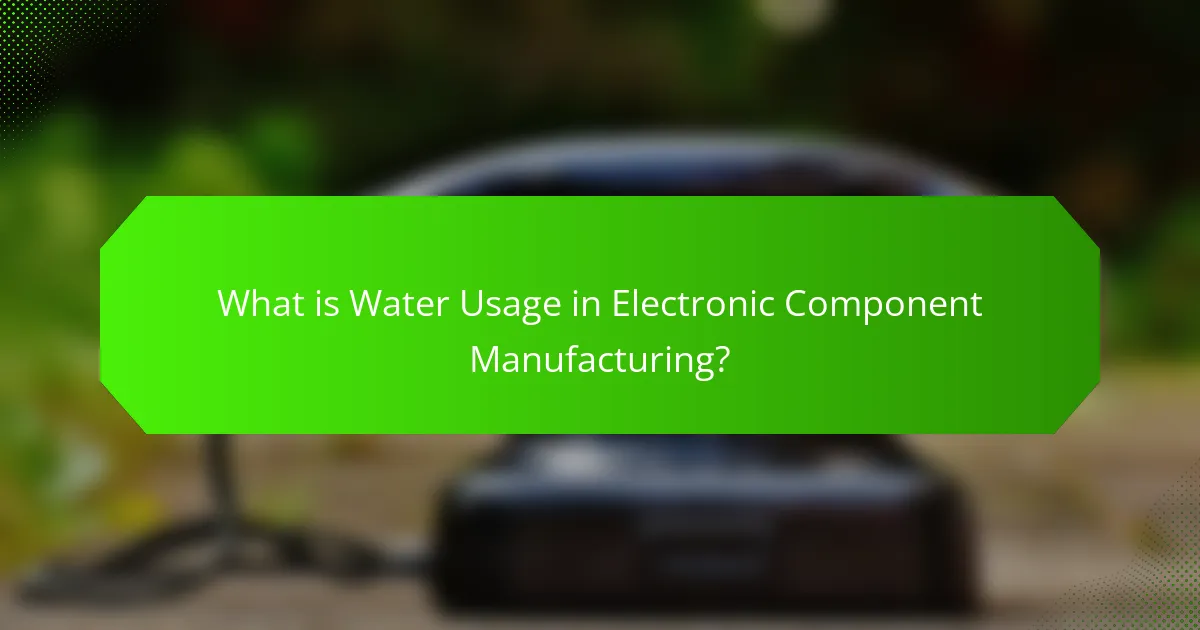
What is Water Usage in Electronic Component Manufacturing?
Water usage in electronic component manufacturing refers to the amount of water consumed during the production process. This industry relies on water for various functions, including cooling, cleaning, and chemical processes. For instance, water is essential for rinsing silicon wafers and other components to remove contaminants.
Research indicates that semiconductor manufacturing can use between 2,000 to 5,000 gallons of water per chip produced. Additionally, the water quality is critical, necessitating high-purity water for specific processes. The industry’s growing focus on sustainability has led to the implementation of water recycling and conservation techniques to mitigate environmental impact.
How is water utilized in the manufacturing process of electronic components?
Water is utilized in the manufacturing process of electronic components primarily for cooling, cleaning, and chemical processes. In cooling, water helps regulate temperatures during production, preventing overheating of machinery. For cleaning, water is essential in rinsing substrates and removing contaminants from components. Additionally, water is involved in chemical processes such as etching and plating, which are critical for circuit board fabrication. These processes often require high-purity water to avoid impurities that could affect performance. The semiconductor industry, for instance, uses ultra-pure water to ensure the integrity of microchips. This multi-faceted role underscores water’s importance in maintaining efficiency and quality in electronic manufacturing.
What specific processes require water in electronic component production?
Water is required in several specific processes in electronic component production. These processes include wafer cleaning, chemical etching, and rinsing. Wafer cleaning removes contaminants from the surface of silicon wafers before further processing. Chemical etching uses water as a solvent to dissolve unwanted material from the wafer. Rinsing is essential to eliminate residues from chemical processes, ensuring product quality. Additionally, water is used in cooling systems to manage heat generated during manufacturing. The semiconductor industry reports that water consumption in these processes can be significant, emphasizing the need for efficient water management practices.
How does water quality impact manufacturing efficiency?
Water quality directly impacts manufacturing efficiency by affecting equipment performance and product quality. Poor water quality can lead to equipment corrosion, scaling, and fouling. This results in increased maintenance costs and downtime. Additionally, contaminants in water can compromise product integrity, leading to defects. For instance, high levels of dissolved solids can affect the conductivity of water used in cooling systems. Research indicates that maintaining water quality can enhance operational efficiency by up to 20%. Thus, ensuring high water quality is essential for optimal manufacturing processes.
Why is it important to analyze water consumption rates in this industry?
Analyzing water consumption rates in electronic component manufacturing is crucial for sustainability. This industry is known for high water usage, which can lead to resource depletion. Understanding consumption patterns helps identify inefficiencies and areas for improvement. Reducing water use can lower operational costs and enhance profitability. It also mitigates the environmental impact associated with excessive water extraction. Furthermore, regulatory compliance is essential, as many regions impose limits on water usage. By analyzing these rates, companies can ensure they meet legal requirements and avoid penalties. This proactive approach contributes to long-term viability in a resource-constrained world.
What are the typical water consumption rates in electronic component manufacturing?
Typical water consumption rates in electronic component manufacturing range from 2 to 10 cubic meters per ton of product. The exact rate depends on the specific processes involved. For instance, semiconductor fabrication facilities often require more water due to cooling and cleaning processes. According to the Semiconductor Industry Association, water usage can vary significantly based on technology and production scale. Some advanced facilities may use up to 20 cubic meters per ton. This variation highlights the importance of efficiency in water management within the industry.
How do water consumption rates vary by manufacturing process?
Water consumption rates vary significantly by manufacturing process. Different processes in electronic component manufacturing utilize varying amounts of water. For instance, semiconductor fabrication processes can consume up to 10,000 liters of water per chip. In contrast, assembly processes may use only a few hundred liters. The type of cooling systems employed also affects water usage, with water-cooled systems requiring more than air-cooled alternatives. Additionally, cleaning processes during manufacturing can lead to high water consumption, particularly in photolithography. Reports indicate that the average water use in electronic manufacturing can range from 1 to 5 million liters per month depending on the process. This variability highlights the importance of process optimization for water conservation.
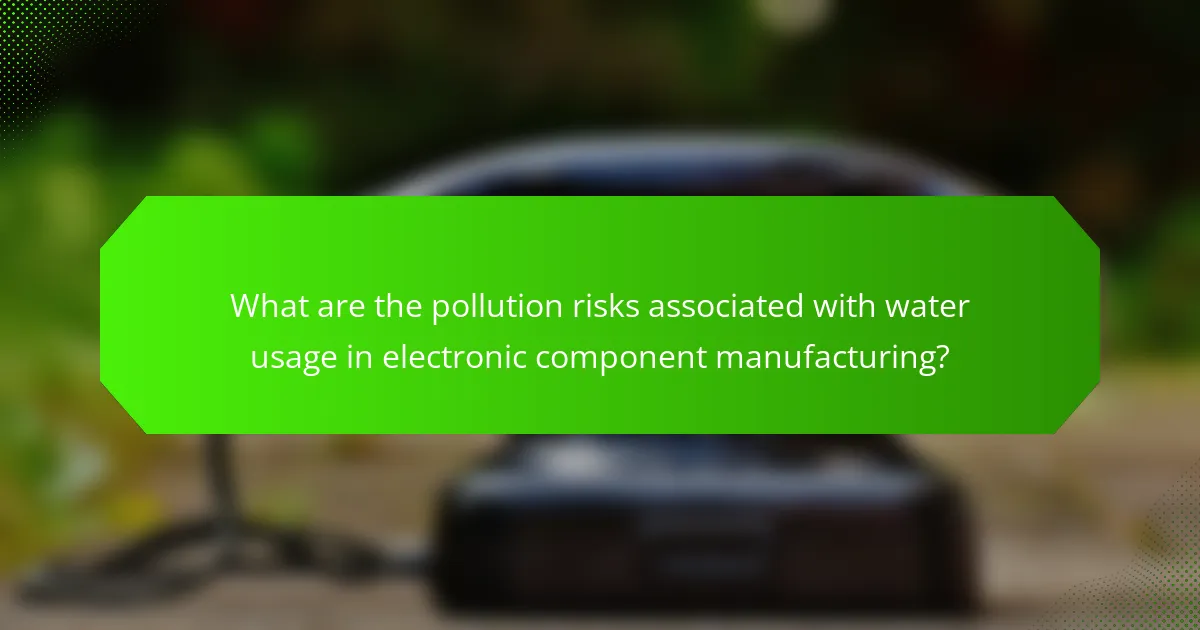
What are the pollution risks associated with water usage in electronic component manufacturing?
Water usage in electronic component manufacturing poses several pollution risks. These risks include chemical contamination, thermal pollution, and excessive water consumption. Chemical contamination occurs when hazardous substances, such as heavy metals and solvents, are discharged into water sources. This can lead to toxic effects on aquatic life and human health. Thermal pollution arises from the discharge of heated water used in cooling processes, which can disrupt local ecosystems. Additionally, excessive water consumption can deplete local water resources, leading to ecological imbalances. According to the EPA, improper wastewater management in the electronics sector can result in significant environmental damage.
What pollutants are commonly found in wastewater from this industry?
Common pollutants found in wastewater from electronic component manufacturing include heavy metals, organic solvents, and acids. Heavy metals such as lead, cadmium, and mercury are often present due to the use of electronic materials. Organic solvents are used in cleaning processes and can contaminate wastewater. Acids, including hydrochloric and sulfuric acid, are used in etching processes, contributing to pollution. These pollutants can harm aquatic life and disrupt ecosystems. Regulatory standards often require treatment to reduce these contaminants before discharge.
How do these pollutants affect local ecosystems?
Pollutants from electronic component manufacturing negatively impact local ecosystems. These pollutants can include heavy metals, solvents, and other toxic chemicals. They contaminate water sources, harming aquatic life. For example, heavy metals like lead and mercury accumulate in fish, leading to bioaccumulation. This disrupts food chains and affects species diversity. Pollutants can also degrade water quality, making it unsuitable for wildlife. Studies show that chemical runoff leads to algal blooms, which deplete oxygen levels in water. Low oxygen levels can cause fish kills and loss of biodiversity. Overall, pollutants from this industry pose significant threats to local ecosystems.
What regulations govern wastewater discharge in electronic manufacturing?
The regulations governing wastewater discharge in electronic manufacturing primarily include the Clean Water Act (CWA) in the United States. The CWA establishes the framework for regulating discharges of pollutants into the waters of the United States. It requires manufacturers to obtain National Pollutant Discharge Elimination System (NPDES) permits for any discharge of wastewater. These permits set specific limits on the types and amounts of pollutants that can be released.
Additionally, the Resource Conservation and Recovery Act (RCRA) regulates hazardous waste management, impacting wastewater treatment processes. States may also have their own regulations that complement federal laws, adding further requirements for wastewater management in electronic manufacturing. Compliance with these regulations is crucial to minimize environmental impact and protect public health.
Why is it crucial to assess the environmental impact of water pollution?
Assessing the environmental impact of water pollution is crucial for safeguarding ecosystems. Water pollution can harm aquatic life, disrupt food chains, and degrade water quality. This assessment helps identify sources of pollution and their effects on biodiversity. For instance, pollutants like heavy metals can accumulate in fish, posing risks to human health. Monitoring water quality also supports regulatory compliance and promotes sustainable practices. Additionally, understanding the impact aids in developing effective remediation strategies. Studies show that polluted water bodies can lead to significant economic losses in fisheries and tourism. Therefore, assessing water pollution is essential for environmental protection and public health.
What are the long-term effects of pollution on water resources?
Pollution has significant long-term effects on water resources. Contaminants can lead to the degradation of water quality. This degradation affects aquatic ecosystems and biodiversity. Polluted water sources can become unsafe for human consumption. Long-term exposure to polluted water can cause health issues in humans. Heavy metals and toxins can accumulate in the food chain. Studies show that industrial runoff is a major contributor to water pollution. For example, the U.S. Environmental Protection Agency notes that 40% of rivers and lakes are too polluted for safe recreation.
How can pollution risk assessments improve sustainability in manufacturing?
Pollution risk assessments can improve sustainability in manufacturing by identifying and mitigating environmental impacts. These assessments evaluate potential pollutants and their sources within manufacturing processes. By understanding these risks, manufacturers can implement strategies to reduce emissions and waste. For example, adopting cleaner technologies can minimize harmful discharges. Additionally, pollution risk assessments promote compliance with environmental regulations. This helps avoid fines and enhances corporate reputation. Implementing findings from these assessments can lead to resource efficiency. Studies show that companies that prioritize sustainability achieve cost savings and improved operational performance.
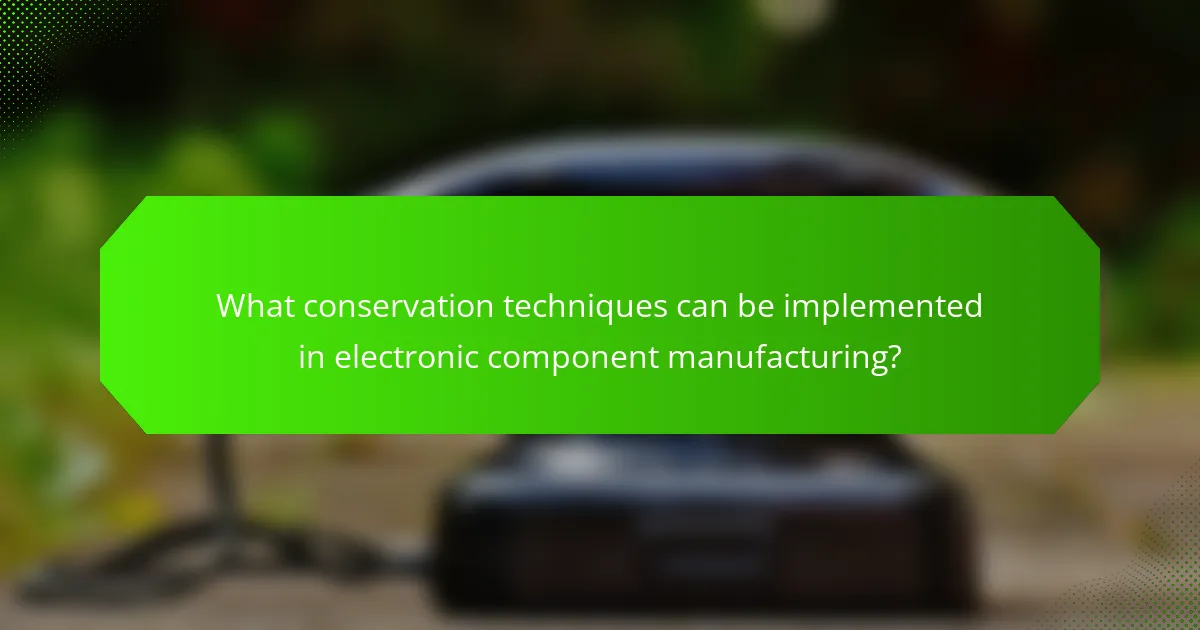
What conservation techniques can be implemented in electronic component manufacturing?
Water recycling systems can be implemented in electronic component manufacturing. These systems capture and treat wastewater for reuse in production processes. This technique significantly reduces overall water consumption. Additionally, closed-loop water systems can minimize water discharge into the environment. They recirculate water within the manufacturing process, thereby enhancing efficiency. Implementing rainwater harvesting systems can also contribute to conservation efforts. This method collects and stores rainwater for non-potable uses. Furthermore, optimizing cooling systems can lead to reduced water usage. High-efficiency cooling technologies lower water demand while maintaining operational effectiveness. These conservation techniques collectively support sustainable manufacturing practices in the electronics industry.
How can manufacturers reduce water consumption effectively?
Manufacturers can effectively reduce water consumption by implementing water recycling systems. These systems can reclaim and purify wastewater for reuse in production processes. For instance, companies can use closed-loop systems that minimize water loss. Additionally, optimizing cooling processes can significantly cut down on water usage. Research indicates that adopting dry cooling technology can reduce water needs by up to 90% in some cases. Regular maintenance of equipment also prevents leaks and unnecessary water waste. Furthermore, training employees on water conservation practices fosters a culture of sustainability. Implementing these strategies can lead to substantial reductions in overall water consumption.
What technologies are available for water recycling in manufacturing?
Technologies available for water recycling in manufacturing include membrane filtration, reverse osmosis, and biological treatment systems. Membrane filtration uses semi-permeable membranes to separate contaminants from water. This technology effectively removes suspended solids and microorganisms. Reverse osmosis applies pressure to force water through a membrane, removing dissolved solids and impurities. Biological treatment systems utilize microorganisms to break down organic contaminants in wastewater. These technologies enhance water reuse and reduce overall water consumption in manufacturing processes. According to the Water Environment Federation, these methods can achieve up to 90% water recovery rates.
How can process optimization lead to reduced water use?
Process optimization can significantly reduce water use by enhancing efficiency and minimizing waste. By analyzing and refining production workflows, manufacturers can identify areas where water consumption is excessive. Implementing techniques such as closed-loop systems recycles water, reducing the need for fresh supplies. Additionally, process optimization often involves upgrading equipment to more water-efficient models, which can cut usage by up to 30%. Data from the Semiconductor Industry Association indicates that optimized processes in semiconductor manufacturing have led to a 20% reduction in water use over the past decade.
What best practices can be adopted for sustainable water management?
Implementing best practices for sustainable water management includes several key strategies. First, conducting regular water audits helps identify usage patterns and inefficiencies. Second, recycling and reusing water in manufacturing processes can significantly reduce overall consumption. Third, adopting advanced technologies, such as closed-loop systems, minimizes water waste. Fourth, utilizing rainwater harvesting systems captures and stores precipitation for use. Fifth, promoting employee training on water conservation raises awareness and encourages responsible usage. Lastly, collaborating with local governments and organizations can enhance community water management efforts. These practices collectively contribute to a more sustainable approach to water management in electronic component manufacturing.
How can employee training enhance water conservation efforts?
Employee training can enhance water conservation efforts by educating staff on efficient water usage practices. Training programs can inform employees about the importance of reducing water waste. This knowledge leads to more mindful behaviors in daily operations. For example, trained employees may identify leaks or inefficiencies in water systems. They can implement solutions that save significant amounts of water. Studies show that organizations with water conservation training reduce water usage by up to 30%. This reduction not only conserves resources but also lowers operational costs. Ultimately, informed employees become advocates for sustainability within the workplace.
What role does monitoring play in effective water management strategies?
Monitoring is essential for effective water management strategies. It enables the collection of real-time data on water usage and quality. This data helps identify inefficiencies and areas for improvement. Monitoring also aids in compliance with environmental regulations. It provides insights into pollution risks associated with water usage. Regular monitoring can lead to better conservation techniques. Studies show that companies implementing monitoring systems reduce water waste by up to 30%. Effective monitoring ultimately supports sustainable water resource management.
What are the practical steps manufacturers can take to improve water usage efficiency?
Manufacturers can improve water usage efficiency by implementing water recycling systems. These systems can reclaim wastewater for reuse in manufacturing processes. Additionally, installing low-flow fixtures can significantly reduce water consumption in facilities. Regular audits of water usage can identify areas for improvement and wastage. Employee training on water conservation practices is also essential. Utilizing advanced technologies, such as sensors, can help monitor and manage water usage effectively. These steps can lead to reduced operational costs and lower environmental impact. According to the EPA, water-efficient practices can save manufacturers up to 30% on water costs.
Water usage in electronic component manufacturing is a critical aspect of the production process, involving significant consumption rates ranging from 2,000 to 10,000 gallons per chip. The article explores how water is utilized for cooling, cleaning, and chemical processes, emphasizing the importance of high-quality water to maintain manufacturing efficiency and product integrity. It also addresses pollution risks associated with wastewater discharge, including chemical contamination and thermal pollution, and outlines conservation techniques such as water recycling systems and process optimization to enhance sustainability in the industry. Overall, the discussion highlights the need for effective water management strategies to mitigate environmental impacts and ensure regulatory compliance.
